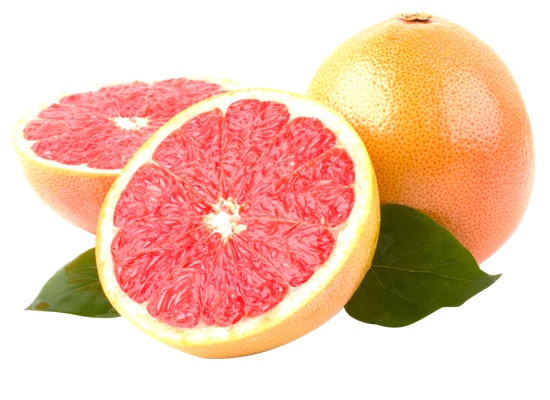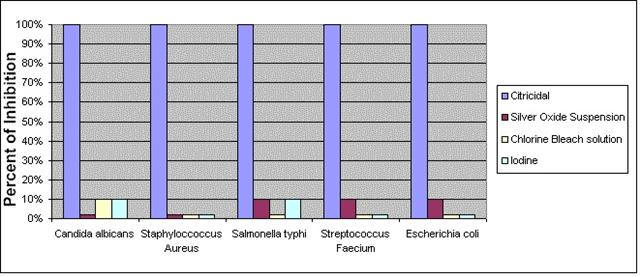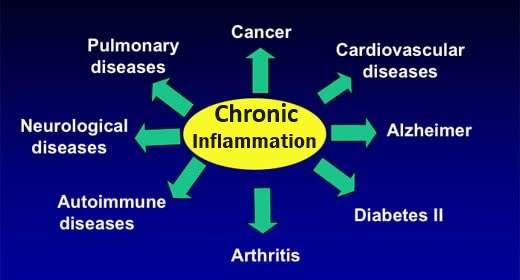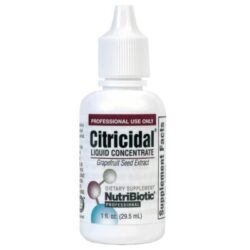Maximum-strength grapefruit seed extract (GSE) (Also known as Citricidal®) - "A medicine chest in a bottle"


What is GSE / Citricidal® and what is it used for?
Citricidal® is synthesized from the polyphenolic compounds found in grapefruit seed and pulp of certified, organically-grown grapefruit. GSE is a rich source of antioxidant polphenols. How is GSE made and what are its active components?
Originally developed by German researcher Jacob Harich (1919-1996) as an anti-parasitic agent, grapefruit seed extract (GSE) was further researched by University of Florida at Gainesville as an effective means of protecting fruits and vegetables from mold damage, who found that GSE could also inhibit growth of bacteria, mold and fungi.
Citricidal® is used worldwide as an antibiotic, antiviral, antifungal, antiparasitic, and antiseptic agent to safely treat or cure numerous ailments in humans, animals and plants. Its benefits include:
- Broad Spectrum germ killer
- Minimal short-term impact on beneficial bacteria
- Non toxic and biodegradable / Long-term use has no negative side effects
- Powerful and effective / Microorganisms do not become resistant
- Well-researched
- Alkalizes blood / Supplies vitamins and minerals
Citricidal® is used against immunodeficiency related diseases. Defends against fungi, bacteria, viruses, parasites or secondary infections that are common in those suffering from immunodeficiency diseases such as HIV positive (Aids) and Chronic fatigue syndrome. GSE’s broad spectrum anti-pathogenic activity relieves the immune system of an enormous burden.
Citricidal® is available in liquid, powder and tablet forms in sizes suitable for personal use.

Citricidal® was found to perform as well as any agents tested at disabling hundreds of different microorganisms
Citricidal® was compared to 30 effective antibiotics and 18 proven fungicides. Bio / Chem Research on Citrcidal , including:
- Bacteria (both gram-negative and gram-positive). Including Campylobacter jejuni, Chlamydia trachomatis (obligate intracellular bacteria), Escherichia coli, Haemophilus influenzae, Klebsiella, Mycobacterium species, Pseudomonas aeruginosa, Salmonella, Shigella, Staphylococcus, Streptococcus pneumonia, Proteus, Vibio cholerae, Legionella pneumophila, Helicobacter pylori
- Viruses. Herpes simplex 1, Influenza A2, and measles virus
- Fungi / Yeasts. Aspergillus niger, Aspergillus fumigatus, Candida albicans, Epidermophyton floccosum, Keritinomyces ajelloi, Monilia albicans, Saccharomyces cerevisiae, Trichophyton mentagrophytes, Trichophyton rubrum, Trichophyton tonsuran
- Parasites / Protozoa. Entamoeba histolytica, Giardia lamblia, Trichomonas vaginalis
Another study found Citricidal® to be effective against a wide variety of 800 gram-positive and gram-negative bacteria and viral strains, 100 strains of fungus and a large number of single or multi-celled parasites. Heggers, 2002,
Relative potency of anti-microbial agents. This minimum inhibitory concentration study was used to evaluate the relative potency of Citricidal® compared to other antimicrobial agents. It demonstrates Citricidal®to be a minimum of ten times(10X) to one hundred times (100X) more effective than other agents tested against the organisms used in this study. Bio / Chem Research on Citrcidal

When used at appropriate doses, no other known antibiotic exhibits such safety and versatility. Citricidal® (as a natural extractive) is listed as GRAS (Generally Recognized as Safe) under the Code of Federal Regulations as 21 CFR 182.20. CITRICIDAL® has been tested for safety in both humans animals and the environment. Citricidal® is considered non-toxic and a non-irritant at dilutions up to 2%. Citricidal® is also considered non-corrosive
Typical doses of Citricidal® do not harm beneficial intestinal flora. One study found that GSE significantly inhibited E. coli (a normal inhabitant of the GI tract), but left the important and beneficial Bifidobacteria unchanged, and only slightly reduced the Lactobacilli species. The conclusion is that typically recommended doses of GSE do not significantly affect intestinal and urogenital flora, while massive GSE doses are likely to compromise beneficial flora. GSE may actually assist the growth of the beneficial bacteria by inhibiting pathogenic microbes which compete with the beneficial flora. The Healing Power; The Authoritative Guide to Grapefruit Seed Extract.

How does Citricidal® destroy bacteria?
Citricidal® disrupts the bacterial cell membrane, releasing its cytoplasmic contents within 15 minutes of contact. Evidenced by using Scanning Transmission Electron Microscopy (STEM). At 1:256 dilution Citricidal® is bactericidal and toxic, but at 1: >512 dilution Citricidal® is bactericidal, but also completely nontoxic. Heggers, 2002
Microorganisms do not become resistant to Citricidal® as they often do to antibiotics. There is no evidence that any type of microorganism has ever developed a resistance to Citricidal®.

Citricidal® is successfully used against fungal mold and yeast
Mold and yeast (both of the fungus kingdom) are just as disease-causing as bacteria and viruses. An estimated 50% of those who are sick have some type of fungal disease. Fungal diseases in the body are more likely with an impaired immune system, which is caused partly by overuse of strong antibiotics and CORTISONE, stress, environmental toxins, unbalanced or insufficient nutrition, food additives, steroids, birth control pills, chlorinated water, etc, which provide an opportunity for fungal growth by offsetting the natural balance of intestinal bacteria. Molds and yeast fungi assist in the development of cardiovascular disease, rheumatism, arthritis, gout, asthma, allergies, sinusitis, gastritis, tuberculosis, cancer, and more.
Citricidal® kills yeast cells by causing apoptosis, a process in which cells self-destruct. Cao, 2012
MycotoxinsMold fungi by-products produce some of the strongest poisons known, called mycotoxins. Many of these molds can be found in food or damp musty areas. If sick, you should avoid foods containing mycotoxins – which can further weaken your immune system and actually feed Candida Albicans. In Germany, it is estimated that 7-12 thousand people die annually of fungal infections. Some of the more common mycotoxins include:
|
Citricidal® is one of the best non-toxic remedies for Candida. According to worldwide reports from holistic physicians and thousands of their patients. In addition, GSE can simultaneously detoxify the system of other fungi, bacteria and parasites that often go hand-in-hand with Candida Ignacio, 2005

How is GSE made and what are its active components?
- Grapefruit pulp and seed is dried and ground into a fine powder.
- The powder is dissolved in purified water and distilled to remove the fiber and pectin.
- The distilled slurry is spray dried at low temperatures forming a concentrated flavonoid powder.
- This concentrated powder is dissolved in vegetable glycerine and heated.
- Food grade ammonium chloride and ascorbic acid are added, and this mixture is heated under pressure. The amount of ammonium chloride remaining in finished Citricidal is 15-19%; the amount of ascorbic acid remaining is 2.5-3.0%.
- The ammoniated mixture undergoes catalytic conversion using natural catalysts, including hydrochloric acid and natural enzymes. There is no residue of hydrochloric acid after the reaction.
- The slurry is cooled, filtered, and treated with ultraviolet light.
Note on recent comments resulting from a German study that it is added preservatives in GSE that are its active ingredients and not the GSE. 6 commercial grapefruit seed extract products were tested in this study, which determined that all 6 contained benzethonium chloride and 3 contained triclosan (a common germicide) and methylparaben – all 3 chemicals toxic to humans. One product contained no preservatives but also demonstrated no antimicrobial activity on the microbes tested. According to the manufacturer, every batch of Citricidal® is certified for the absence of not only pesticide and herbicide residues, but also the absence of the preservatives benzethonium chloride, triclosan and methylparaben. United States Testing Company Report No. 405993, dated 9/8/95 supposedly confirms these results, but this author has been unable to locate it on the web. The results show that without these preservatives present, Citricidal® displays very strong antimicrobial activity. Additionally, every batch of Citricidal® is tested and certified free from chemical and heavy metal contamination.
One explanation for the study’s findings is that Citricidal® has a similar molecular weight to benzethonium chloride and may have been misidentified.
Citricidal’s General Manager, Richard Perry, gave the following response to the question “Can you tell us how it is manufactured?” in an interview by a board member of the Natural Ingredient Resource Center: “We cannot give you our proprietary process. All I am willing to offer is that we start with grapefruit bioflavonoids and convert them into a quaternary ammonium compound similar to a known, but toxic, compound called benzethonium chloride. The difference is our product has an oxygen and carbon bond that is different than that of benzethonium. Our product also has an LD50 of over 5000 mg/kg of live body weight. That means that an average weight human would have to consume a quart of CITRICIDAL daily before there would be a 50% chance of death as a result. Our product is used by the drop”. Citricidal has been used worldwide for over three decades with no reports of it having caused harm to anyone and yet there are thousands of both clinical and anecdotal reports of how it has helped people with many microbially related health issues. Bottom line – you will need to come to your own conclusion on this.
References
Biochem Research on Citricidal pdf
Cao S, Xu W, Zhang N, Wang Y, Luo Y, He X, Huang K. (2012) A mitochondria-dependent pathway mediates the apoptosis of GSE-induced yeast. PLoS One. 2012;7(3) PLoS One PubMed
Heggers JP et al (2002) The Effectiveness of Processed Grapefruit-Seed Extract as An Antibacterial Agent: II. Mechanism of Action and In Vitro Toxicity, J. of Alternative and Complementary Medicine. PubMed
Ignacio, Ciara, Thai, Dorothy (2005) COMPARATIVE ANALYSIS OF ANTIFUNGAL ACTIVITY OF NATURAL REMEDIES VERSUS MICONAZOLE NITRATE SALT AGAINST CANDIDA ALBICANS California Polytechnic State University. pdf
The Healing Power of Grapefruit Seed by Shalila Sharamon and Bodo J. Baginski.
The Authoritative Guide to Grapefruit Seed Extract, by Allan Sachs, D.C. C.C.N















